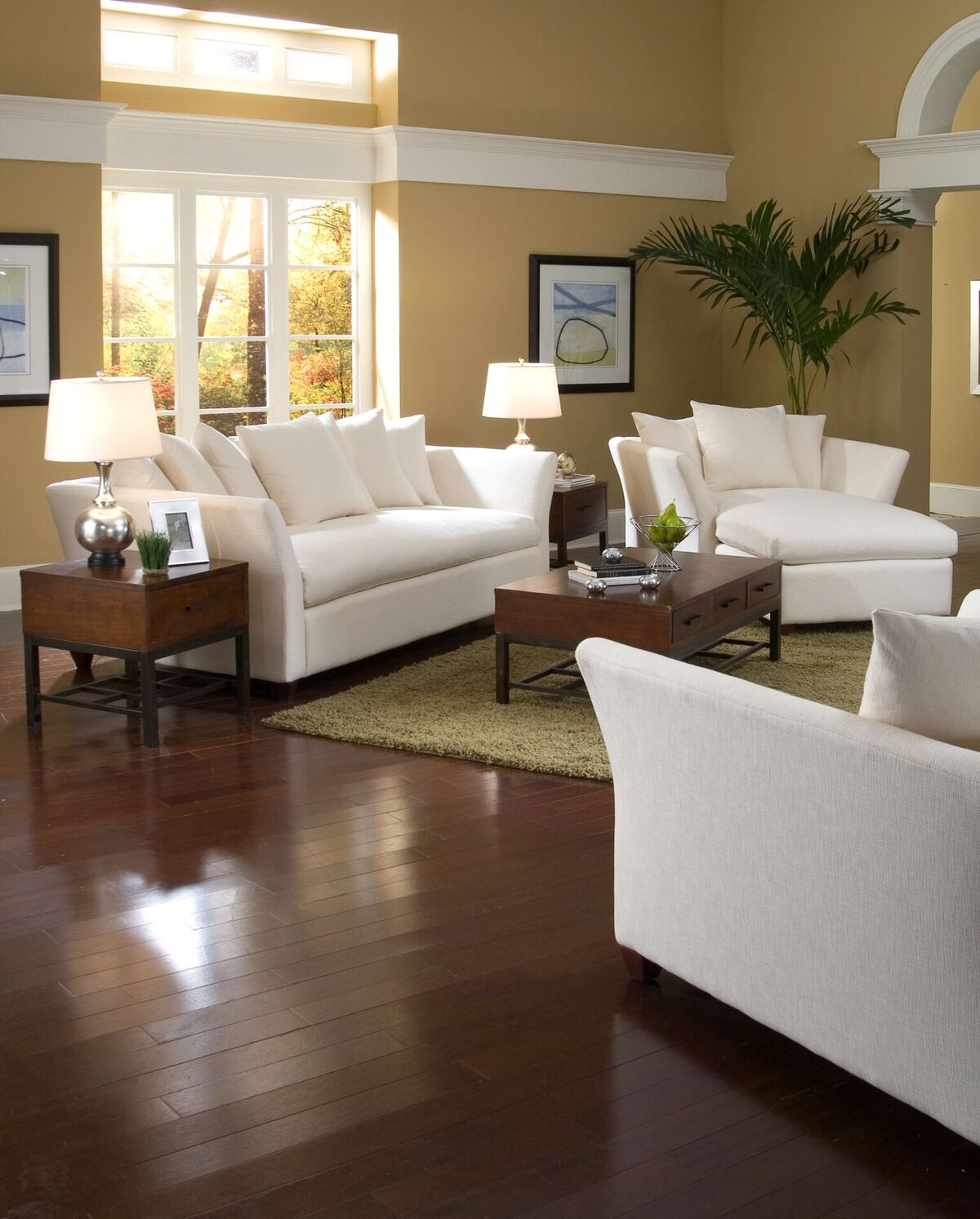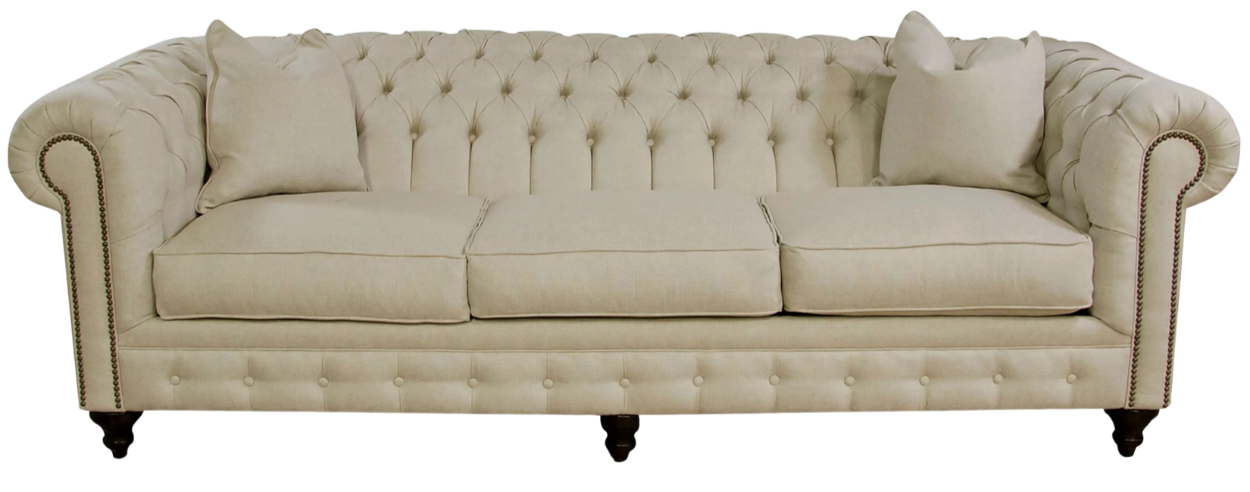Your Cart is Empty
RUGS
FURNITURE
The Essence of Design, Part 4 - Tying it All Together

Welcome to the final in our series of four blog posts covering the basics of interior design methodology. In Part 1, Part 2, and Part 3, we covered the basic tenets of interior design, and discussed the key considerations you need to bear in mind as you craft your design.
In this final post, we’ll use a case study to demonstrate how to tie all of these elements into a complete room and provide step-by-step insights and considerations as we go along.

The Klaussner Room
The Klaussner room is an exquisite example of a room that maintains a simple beauty yet allows people to enjoy a leisurely atmosphere of conversation and relaxation, and will make an excellent example of the essentials of interior design in action.
Gauging the Space
The first thing that I’m going to do is measure out my space. I can already tell that the room is very wide and tall, with ample space to accommodate any furniture choices, as well as plenty of room for walking. There are only three available plugins that I can use, but there is a large, beautifully-framed window that will allow plenty of natural light to permeate the room.
The window also opens out into a beautiful patch of woods that lends a natural quality to the room. I also take note of which way is North, since I want to know where the sun will rise and set and position any furniture so that guests aren’t looking directly into the sun. Even as I gauge the space, I also note that the hardwood floor is a deep, earth-colored brown that looks absolutely gorgeous, and I don’t have any desire to change it. This will be important later.
Once I have everything measured, I’m going to make a rough sketch of the room to record my measurements and mark the window and the electrical outlets, that I can use as a template to start crafting my design.
Determining the Purpose
Now that I have my measurements, I can start to decide what I want this room to do for me. The open archway doors rule out a bedroom, or anywhere else that would require privacy, and I want to take advantage of the natural beauty of the sunlight and trees. I’ve determined that a sitting room, where I can entertain guests, or lounge and read in peace and quiet, would be the perfect way to utilize this room.
With a general purpose in mind, I start to think about what I’ll need to achieve that purpose. I decide that the window will be the centerpiece of my room, and I want to arrange everything around it. Since this room smoothly feeds into other parts of the home, I need to keep a fair amount of walking space open and position any furniture in a way that it won’t impede anyone moving through the house.
To accommodate any guests we have, I’m going to need ample seating space, but I’ll need to create it in a way that doesn’t restrict movement. I decide that a single couch, coupled with a loveseat and chaise lounge, will provide plenty of seating space whether I’m entertaining guests or just enjoying the sun on my own.
I also decide that I want to limit any food being eaten, but will allow drinks, so I need some space to sit glasses down or stack books and magazines, so a coffee table, with two end tables, will work perfectly. I’ll also include two lamps for when the sun goes down. Finally, I’m not too concerned about staining the hardwood floor, but I do want to protect it from any scuffing the coffee table and chaise lounge might cause, so I’ll need a high quality rug that will protect it.
From here, I can start to add to my sketch, using a different color, to mark possible positioning and dimensions for furniture. I can refine this later, so for now, I’m worried mostly about spacing and leaving the walkways open, while using the sunlight for reading and atmosphere.
Selecting My Theme
I’ve determined my purpose and know the specific pieces and considerations I’ll need to make it happen, so now I can select my theme. Since I want to be able to converse freely with others, or read in peace, I want the room to have a relaxed, soothing feel. I want minimal decorations so that people can focus entirely on conversation, or their book, without being distracted by the room itself.
I already noted that the hardwood floor has a lush brown color that ties in perfectly with the woodline through the window, and I decide that I can enhance that to create a natural look, almost like the room is a part of the trees and plants outside. It will help me create that relaxed atmosphere and give a unique touch to the room.
With all this in mind, I decide that my theme will be, “Relaxing, soothing, natural and minimal.”
Choosing the Colors
To help match my theme, I decide to take advantage of the colors already provided by both the floor and the landscape outside. I need colors that reflect those we find in nature, and to get me started, I look at the different hues used in the Gabbeh Rug collection. They have natural, subdued colors, and I can see that browns, yellows, and greens dominate the palette. It’s a good starting point to apply the basics of color theory to help me determine exactly what I want to use.
Referencing the color wheel, I start with green, since that is the color most commonly associated with the earth, and check the adjoining colors to see what’s close by. I see that yellow and blue are right next to green on the color wheel, and yellow is already represented by the fall leaves and sunlight, so it will definitely work, so long as I keep the yellows subdued to avoid fostering too much energy.
I decide to avoid moving to the other side of the color wheel, even though red would compliment the green I’m using as my base. Reds are beautiful, but red carries the risk of generating passion or excitement, which is not the sort of emotion I want to convey with my room. Oranges and purples will also start to take me too far from the common earth hues that I want to capitalize on, so I decide to avoid them.
With these considerations in mind, I ultimately decide that I will go with an analogous color scheme, with green being my base color, and incorporating rich shades of brown and tints of yellow to accent my room, along with some neutral white to create some variety that won’t be distracting.
Selecting Materials and Textures
Now that my colors are set, I want to give some thought to the materials and textures that I’ll need to help support my room, while maximizing the comfort level.
For the couch, loveseat, and chaise lounge, I need something soft, that will conform to the shape of my family and visitors, like it’s wrapping itself around them in a gentle embrace. Since I’m not worried about damage from rough use or shifting furniture, and I’m not terribly concerned about stains, I decide that linen will be the perfect option to achieve what I want. Linen will provide the soft, comforting feel that I’m looking for, and the texture is smooth, but still gives a handwoven impression that will fit beautifully within the natural look I’m going for.
For the rug, I want something soft that will caress the feet, while also being resistant to staining if we do have a drink spill, and durable enough to prevent scuffing. I select polyester, both because it is soft and easy on skin, but also because it is resistant to stains and fairly easy to clean. The texture also has the strands rising up to caress the feet, almost like a miniature forest, so I know it will perfectly accent the trees outside.
To round out my decorations, I decide that a nice areca palm in the corner will tie in beautifully with the outdoors and create the impression that the room is an extension of the landscape. I use simple, modern designs with smooth curves, that don’t require a lot of study for my clock and lamps, to accent my space. Finally, I use two identical pieces of wall art, with colors that match my palette, to create a refined look, and position them in a way that draws attention to my window as the centerpiece.
A Room That is a Work of Art
The final design is the Klaussner room - a breathtaking space that will ensure my family and guests are comfortable and at ease, whether we’re talking or reading. By taking advantage of the elements already provided, I’ve created a space where natural colors and lighting create the impression that you’re stepping into a beautiful forest and letting the gentle touch of nature wash over you.
By keeping the basic principles of interior design in mind and creating a natural balance between the space and purpose, I was able to determine a clear and simple theme to guide my design. From there, I was able to find a color scheme that fostered the emotions I wanted, with materials and textures that not only support my purpose, but accent the room beautifully.
The Home You’ve Always Dreamed Of
I sincerely hope you’ve enjoyed this series, and that the world of interior design is a little less mysterious to you now. Using these basic tenets, anyone can start to craft a beautiful design that will result in a home that welcomes their friends and family in and invites them to stay awhile.
You may still not be ready to tackle everything yourself, and that’s perfectly fine. There are plenty of people and resources available to help you, and this guide is only the start. Consult the experts and use everything you can find to design the home of your dreams. Now, go and create something beautiful!
